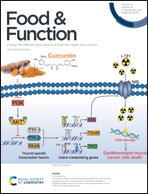Lactobacillus casei LC89 exerts antidiabetic effects through regulating hepatic glucagon response and gut microbiota in type 2 diabetic mice†
Abstract
Previous study suggests that Lactobacillus casei exhibits antihyperglycemic activity, however, the molecular mechanism of this has yet to be elucidated. Here, the anti-diabetic effects and underlying mechanisms of Lactobacillus casei LC89 are investigated in type 2 diabetes mellitus (T2DM) mice, which was induced by a high-fat diet (HFD) with streptozotocin (100 mg per kg BW). The results show that LC89 at a dose of 109 CFU day−1 decreases fasting blood glucose (FBG) and insulin levels by 35.12% and 28.37%, respectively, compared to the diabetes control (DC) group. Moreover, LC89 treatment improved the insulin resistance index (HOMA-IR), serum lipid profiles and inflammation cytokines. The real-time polymerase chain reaction indicated that LC89 markedly downregulates the mRNA expression of hepatic glucagon (GCG), glucagon receptor (GCGR), phosphoenolpyruvate carboxykinase (PEPCK) and glucose-6-phosphatase (G6Pase). Meanwhile, LC89 significantly decreases the abundance of Odoribacter, but increases the Alloprevotella, Bacteroides, Parabacteroides and Ruminococcus content. Therefore, LC89 plays a positive role in alleviating T2DM by regulating gut microbiota and glucagon signal pathway-related genes, and it may be a beneficial dietary supplement to regulate glucose metabolism in T2DM.



 Please wait while we load your content...
Please wait while we load your content...